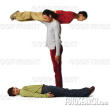Go Right Down the Middle
by Art Ticknor
|
Now this is what they really mean in this Zen literature about no-mind.
They mean the point where the head stops. And they talk occasionally about
killing the Buddha, or killing the mind. But you can't kill your mind. These
were terms that were either lost or had something wrong with the translation,
or misinterpreted. The mind is killed for you. You can't set out to kill your
own mind. The only thing you can do is set out to find the truth. But in the
process of finding the truth, you have to somehow put a stop to this relative
hassle that goes back and forth: "It could be this but it also could be
the opposite. Or let's look at it from two sides." No, you have to go
right down the middle. Look at it directly. Become one with it. You can't
reason it out, back and forth.
An inquirer asked: I don't know if Harding would have agreed, but based on my observation of the mind, the bidirectionality of two-way seeing is like an alternating current: attention is either directed outward or backward at any instant, but not both. Looking outward, we see the truth of a percept, such as the picture of a tree that appears in our mind, merely by noticing the percept. If the thought "oak tree" is triggered by the percept, we may have to do some investigation to determine the truth of that concept. When we feel the sense of self, our I-amness, we look backward, in the direction of what/where we're looking out from, to see or find it. And typically we don't see or find anything when we look back in that direction. In fact, what we're looking for seems to jump behind us quicker than our attention can find it. But at some point, most always after years or decades of struggle, we become conscious of awareness. By that I mean that we can somehow see or look directly at awareness. We don't see any thing, but if we look sufficiently, we become consciously aware of its single characteristic. Once that occurs, if we've previously whittled our individual self-definition down to the last faulty remnant, that last remnant will be exposed as an illusion. At that point, a huge discontinuity can occur, and the observer merges with the observed. We recognize the Truth by becoming it … or become It by recognition. Addendum from Bob Cergol: What you write makes good sense. Yet it's still just words and [the questioner] is overly concerned with them. I agree with what you write—yet I could spin contrary-sounding words and claim there is no bi-directionality in seeing. Everything seen is outward—so when you say we look backward, or inward—we are still looking outward. Whenever there is an object seen—that object is external/outer. I like [Franklin Merrell-] Wolfe's phrase "Consciousness Without an Object"—which you could also describe as "when the attention becomes the focus of attention" or better yet "when there is no object of attention"—awareness needs no object to be … aware. I think the middle Rose referred to was in the context of the polar opposites: good/bad, beauty/ugliness, etc. I think without exception, all of the polar opposites can be traced to the root dilemma: life/death, existence/non-existence, etc. So long as the mind interprets every perception/experience as either affirming or denying the self, the attention is distracted by objects—the root object being the "I am" … this body, this personality, this mind. Even denial and pain is self-affirming, or so the mind spins it. The "middle" is ever-present … and hidden by the mind's preoccupation with objects (again, the self being the root object). Rose said when the mind stopped—was on dead center—then Eternity fills the void—or words to that effect. We're talking about the same thing. Addendum from Shawn Nevins: I don't think Rose was being nearly as precise as you. I find it equivalent to his enigmatic "employ whatever means necessary," or "go within." We have a sense of it, but it's hard to explain. I guess he felt explaining too much was cause for more misunderstanding. The idea of confrontation seems to me to encourage "consider this, consider that," thinking, though at a point it also encourages "stop wobbling." I think the last paragraph you wrote is somewhat specific to you/an unknown subset of the population. It's a "good" answer in that it doesn't seem messy—very "if, then." Perhaps, my reaction is due to my general feeling of "I don't know shit," about anything in this world, so in terms of my realization, I really don't know what I did that I can break down to "if, then." There is a whole lot of "maybe." (And there we have it … the vote is in. Now go right down the middle!) I would add that, in my case, the mind did not need to "stop" (although I assume it may for many people). My conclusion is that mind movement has to not interfere with observation "when the attention becomes the focus of attention," in Bob's words, in order for the mind to open fully to self-realization.
Go to:
More articles by website author |
Main Articles & Excerpts Page |
PSI Home Page |
Self-Discovery Portal
© 2000-2026. All rights reserved. |
Back to Top |
 Is the middle just plainly seeing what you're looking out of and at? Like [Douglas] Harding's bidirectional attention without intention?
Is the middle just plainly seeing what you're looking out of and at? Like [Douglas] Harding's bidirectional attention without intention?